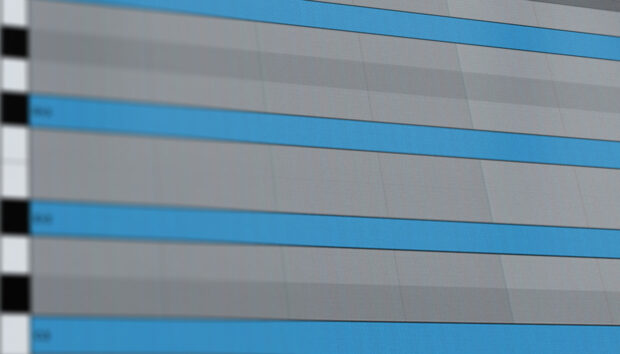
The mind behind RAZOR, Errorsmith, a.k.a. Erik Wiegand, is a musician, developer, and hardcore REAKTOR aficionado. Following on from the release of new album Superlative Fatigue, Erik discusses his work with Native Instruments and the intimate relationship between his plugin development and music making.
“RAZOR is very technical, but it’s also a piece of art for me,” Erik Wiegand confesses. In the wake of his new Errorsmith album Superlative Fatigue, Native Instruments looks at the intrinsic connection between the instrument and the music, and how both share the same technical and artistic vision.
Cutting-edge synth RAZOR combines unique additive synthesis techniques with an intuitive interface that makes it much more practical than typical additive synths. The story of its development dates back to the early days of Native Instruments. “I was employed from ’99 to ’04 at Native Instruments. At first I was responsible for quality control and later on the REAKTOR Library, communicating with outside builders while also building stuff for the Library.” Leaving in 2004 to concentrate on music, Erik stayed with Native Instruments in a freelance capacity, building instruments for the REAKTOR Library.
“Whenever a REAKTOR update came out, it would come with a selection of instruments, and I was one of the people who contributed.” It was during this period that Erik had the idea that eventually grew into RAZOR: a sawtooth oscillator through a filter, with a simple synthesizer structure. “The idea was to use additive synthesis to recreate features of other synthesis forms – that would be powerful because you can be extremely precise. And when I realized that RAZOR would make a great piece of REAKTOR content to sell separately, I spent more time developing it.
“The only restriction I usually have when I make a record is that I just use one set of tools”
“When I do something like RAZOR, something for other people to use, I cannot help to always have myself as a user in mind. My personal preferences went into it. For instance, I like it when the parameters are very wide. So with the pitch knob – a very unremarkable parameter – you can change the pitch by 10 octaves. I want it to pitch down so that you don’t hear the sound anywhere, and I want to pitch it up so high that it disappears! If you play with it, you realize how inspirational such a simple preference can be.”
Before working at Native Instruments, Erik was already making music as MMM with Berghain resident DJ Fiedel, and he later went on to found the Errorsmith production alias. “Without REAKTOR and [REAKTOR precursor] Generator, there wouldn’t be Errorsmith,” he reveals. “I made music with hardware until VST came about – that was when computers became fast enough to handle this stuff. Generator was the start of my very own synthesis research. There are a lot of rehashed synths out there, and with RAZOR I really wanted to have something outstanding. It’s quite rare that I see any synthesizer-ware that embodies new ideas. I find that people are essentially often buying the same synth again and again, especially with hardware.”
Although creative synthesis and REAKTOR in particular are very close to Erik’s heart, he has mixed feelings about the current fashionability of modular hardware synthesizers. “I find it impractical for my workflow. You have a nice patch, which you spend hours on making … but don’t think it’s worth saving? It means you have to finish it there and then. In two hours, it doesn’t sound the same – you change a little bit, and it’s destroyed immediately. I’m not this kind of person. I want to have total recall. I want to be able to return to it with fresh ears and make adjustments and automations while working on a musical piece.” Erik does acknowledge that this trend towards modular synthesizers will lead to users having a greater understanding of synthesis. “They will understand that the synthesizer is not a fixed combination of things. In non-modular synthesis, you have other people who have already decided for you what the ‘correct’ or most useful architecture is. You find out your own way and that’s amazing.”
Another criticism he has with modular hardware hype is that it’s limited to those with money. “I get put off a little bit if I see huge modulars with people standing in front of them; it reminds me of people standing in front of their cars; it’s boasting about how much money you have. My interest in all this was born from a time when it was more normal to just start your own thing. I always saw limitations and then I wanted to go further. I started to open up my analogue synthesizers and tried to modify them. I didn’t know enough about it, and then I made two modules in the mid-’90s for modular synthesizers. One worked and the other one never worked. I realized, ‘OK, I’m not bright enough to fix it.’ That’s what I like about DIY: it’s more about the ideas and the knowledge. Of course, REAKTOR costs money, but it’s nothing in comparison to modular hardware. What’s cool about BLOCKS is that it smooths out the learning curve of REAKTOR.”
REAKTOR has alway been of fundamental importance to the Errorsmith project, though the way Erik works with the software has changed on the latest album. “This record was an exercise in finishing, and a burden on my self-esteem. If, at the end, there is no music, I’m really disappointed,” he confesses. “The only restriction I usually have when I make a record is that I just use one set of tools. With all the records before 2004, it was always just one big REAKTOR patch built only to make this one record I had in mind. This time it was a bit different because I was using RAZOR, a general purpose synthesizer I made mainly for others to use. I always like to use REAKTOR because I can dive into it and change stuff. When I make music, I like to keep some things very repetitive but have the sound changing. Synthesizers are more powerful for this than samplers, that is why I don’t use samples that much. On the new album even the vocal-like sounds are all done with RAZOR, which has a vowel filter.”
“Pitch is so important for our recognition of real voices, so I spent quite a lot of time getting the pitch right on the track ‘Lightspeed’. With the vowel filter, I can change and modulate the singer types. It’s not so easy to make an understandable sentence, and with different consonants, it makes it much more complicated.”
Perhaps surprisingly given his meticulous approach to sound design, Erik’s music-making workflow revolves around jamming. “I’m very bad at arranging stuff!” he admits. “I set up my instruments with several sound sources running with differing patterns. I then do some mapping on the fader box, press record, and I jam it, ideally, in one go. It’s similar to how I play live. My live set is full of instances of RAZOR, 30 or more, just so I can turn all these knobs while I play. My plan is to work on my live set and just do recordings when I rehearse or play live. I don’t mean audio recordings, but like the whole automation. I have all the options open and can add more parameter automations, which wouldn’t be possible if I would use audio clips. I’m a diehard synthesizer guy – like, I really love it! Of course, you can import sounds into a sample mangler, and then be creative again, but I like to be creative at the source. Always.”
Errorsmith’s Superlative Fatigue is out now on Pan.
photo credits: Camille Blake















